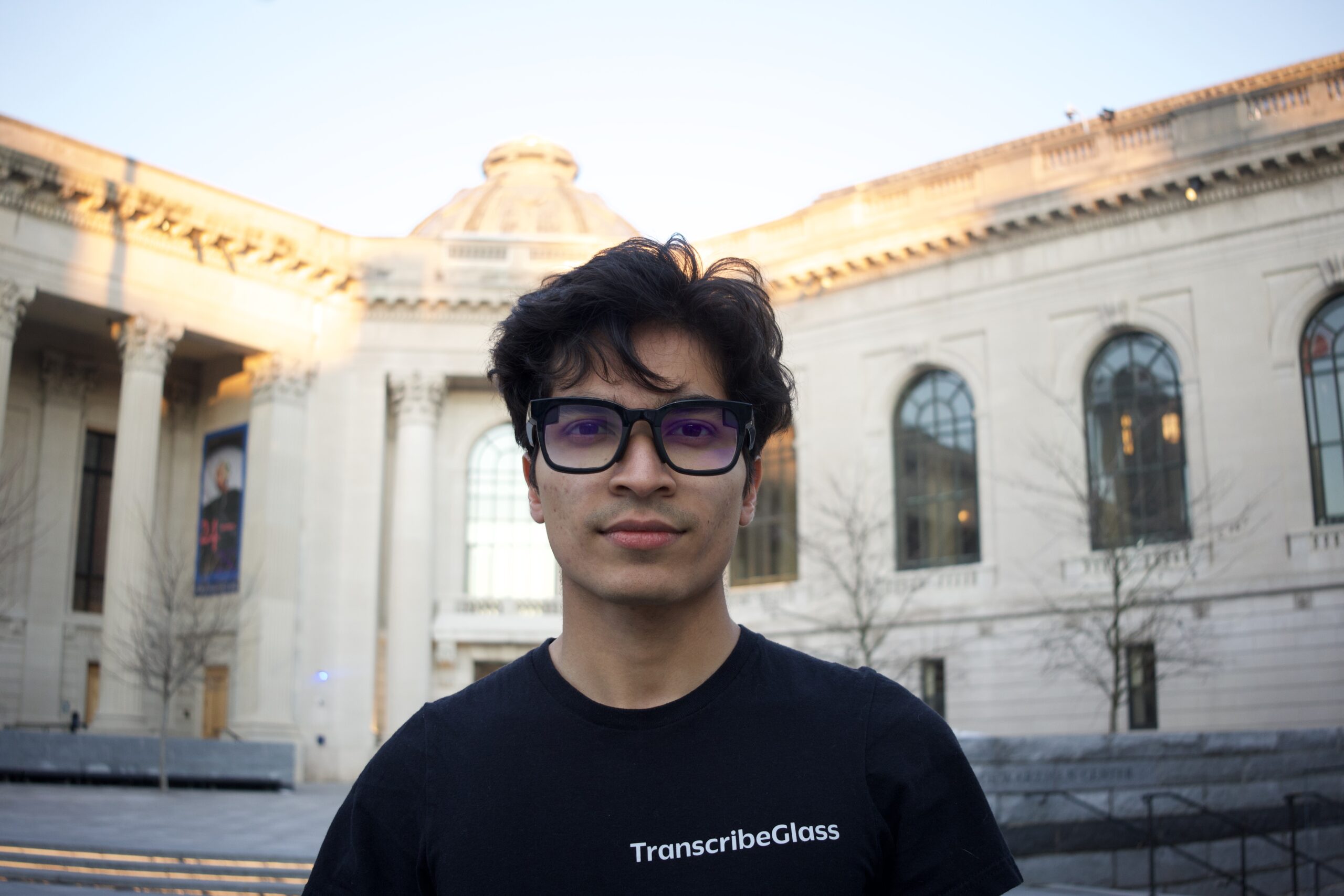Yale student founds TranscribeGlass, a live speech-to-text transcription device
Madhav Lavakare ’25 created the glasses as a more accessible hearing aid.

Courtesy of Madhav Lavakare
TranscribeGlass, a company that produces glasses with live text-to-speech transcription, will launch this week.
The company develops glasses that allow hearing-impaired users to engage with the world around them through closed captioning. An external microphone, like a phone microphone, picks up conversations, and the transcription is displayed in green letters on the glasses. Founder Madhav Lavakare ’25, who studies computer science, has been working on TranscribeGlass for upwards of seven years.
“[Our consumers] have been waiting, and I owe it to them to deliver something that is really good and is going to solve a lot of problems and change their lives,” Lavakare told the News.
In high school, about seven years ago, Lavakare became aware of how expensive hearing aids and cochlear implants can be.
He also knew people who felt these devices were inaccessible.
“That’s when I thought, what if we could take speech recognition, take the closed captions that already exist, just in a really inconvenient form, and put it in your field of view with smart glasses?”
Lavakare has been interested in building devices for a long time, and he started coding and playing around with hardware and electronics when he was young. Whenever he noticed a problem in his life, he wondered whether he could build something to fix it. As a kid, he remembers when his family told him that he couldn’t use the oven to make chocolate chip cookies, so he decided to make an aluminum, solar-powered oven instead.
When he started working on TranscribeGlass, he combined his knowledge of hardware, electronics, mechanical engineering and 3D printing to create a prototype. The hardest part was learning how the optics of the device would work.
“I took apart an old, small projector, and I kind of looked at the guts of it and tried to figure out, okay, what’s going on there,” Lavakare said. “I learned a little bit more about the imaging techniques and designed a very basic system.”
Lavakare took two gaps before entering Yale in order to work on TranscribeGlass. Over five years, he’s conducted field trials with over 500 deaf and hard-of-hearing people in the United States, Europe, Australia and India, and he’s created seven versions of the prototype.
Lavakare has worked with various advisors and collaborators throughout the inventing process, including various hardware founders. His team consisted of five or six people, who would rotate in and out. Currently, his Chief Technology Officer is Nirbhay Narang, who joined the team in August 2024. Narang works on the software for TranscribeGlass.
“We work with manufacturers who give us their hardware, and then we put our software on the glasses,” said Narang, “which is why software is particularly important.”
Narang has overcome some engineering challenges while working for TranscribeGlass, including making the glasses usable both online and offline. It was important to make sure that the transition was seamless between the online version, when the user has a Cloud connection, and the offline one, when they don’t.
Additionally, Narang and Lavakare have worked through communication difficulties.
“Because of the geographic differences, sometimes it’s hard for us to sync up. So we’ve become very disciplined in how we report progress to each other, because it’s very important for the other person to know what we’re doing.”
Narang is excited about the future software engineering opportunities that TranscribeGlass creates.
He believes there is room to make TranscribeGlass more complex, including using more AI features.
“One of the features that we’re working on adding right now is prosody, or tone of speech detection, which essentially tells you what the person who you’re talking to is feeling,” Narang said. “That has a lot of applications for people who have difficulty processing emotional responses, for example, people on the spectrum.”
Amy Husmann became a Beta-Tester for TranscribeGlass during summer 2024. Husmann, who is completely deaf in one ear and has significant hearing loss in the other, has difficulty understanding people in noisy environments, even with her cochlear implant and hearing aid.
With TranscribeGlass, Husmann said she is able to process speech much better in everyday situations, like going to church, having conversations at dinner and going to the theater. The transcription that appears on the glasses is very accurate, she said. She also appreciates how subtle the glasses are.
TranscribeGlass also connects via Bluetooth to an app, which allows users to control their settings.
“They look and feel pretty much like ordinary glasses and I can wear them for long periods of time without getting uncomfortable,” Hussman said.
Husmann also appreciates that TranscribeGlass strives to be financially accessible, since other hearing aids can be more expensive, or aren’t covered by insurance.
“There is amazing hearing assistive technology out there, but it is beyond the budgets of many people who could benefit from it,” Hussman said.
The glasses will be sold at $377 per pair, plus a $20 monthly subscription fee.
While there is a monthly subscription, which will cover the cost of transcription services that the glasses need, Hussman doesn’t think it’s cost-prohibitive.
Lavakare is excited to launch TranscribeGlass and continue working on the company in the future.
While he wants to continue developing new inventions once he is satisfied with TranscribeGlass and the impact it has created, he feels extremely invested in it right now.
“I’ve spent almost 30 percent of my life working on this,” Lavakare said. “Right now, I’m very focused on getting to a stage where the people who need it can get it [accessibly]. That’s going to take a pretty long time, and I’m committed to this.”
1 in 8 people in the United States ages 12 or older has hearing loss in both ears.







